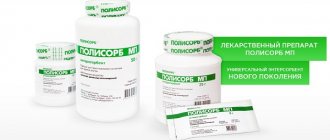How to tell if a newborn has colic
This is determined by the following criteria:
- the baby cries loudly, alternately pulling his legs towards his stomach and straightening them;
- the tummy is swollen, when tapped, a sound similar to hitting a drum comes out;
- in between attacks, the child greedily sucks at the breast;
- the attack ends after the passage of gas or feces, but not always.
Remember that colic is a dysfunction of the intestines, so the characteristics of feces do not change, the baby is gaining weight well, and in the interictal period behaves quite well. Another typical feature of colic is that it begins and ends at approximately the same time, most often in the evening, less often at night. In some cases, the time coincides literally up to 15–20 minutes.
Severity of intestinal colic
There are 3 degrees of severity of infant colic:
- Typical. Such colic in infants appears at one and a half months of age. The attacks progress up to 2 months - they become longer and more frequent, after which the symptoms subside. By 3–4 months, the baby completely gets rid of spasms.
- Persistent. This form is characterized by the continuation of painful attacks after the baby is three or four months old. Such colic is often observed in children who suffer from concomitant diseases.
- Late. This species is characterized by the appearance of painful sensations at a late age (after 3 months).
It is important not to confuse the last two forms.
How to get rid of colic in a newborn
There is no universal medicine that could help a newborn with colic. An individual approach is needed, and only through trial and error will a mother understand how to deal with colic and what helps the baby from it.
The easiest way to help a baby with colic is heat. Some sources recommend applying a diaper heated with an iron to the tummy, but this has a significant drawback - it cools down too quickly, and the mother does not have time to rock the baby with one hand and iron and apply the diaper with the other.
It is much better to use a regular heating pad - pour a little boiling water into it, wrap it in several layers of cloth and apply it to the crying child’s tummy. Unroll the fabric as it cools. As an option, hold the baby upright, holding him close to you, and place the heating pad in the middle.
The pharmaceutical market offers a huge number of anti-colic drops and teas for newborns. Of the former, drugs containing simethicone or dimethicone are most often recommended. These are substances that reduce the surface tension of large gas bubbles, promoting their disintegration into many small bubbles and removal from the body. Simethicone and dimethicone act only in the intestines, so they cannot cause harm, but it is better to consult a doctor before taking them. He will tell you the exact dose and frequency of administration.
Anti-colic teas contain fennel, anise and other carminatives, which also help remove gas and reduce cramps. After agreement with the pediatrician, it can be given to the baby.
Gas emissions in newborns while breastfeeding: what to do if there is increased gas formation?
Flatulence is a common problem. Many pediatricians believe that this is a normal stage of development associated with the immaturity of the digestive system.
Correct feeding technique will help avoid this. When putting your baby to your breast, make sure that he immediately grabs the nipple, and the head should be slightly higher than the body.
The problem of gas and colic is considered quite common. Gases in newborns accumulate in the small intestines and are accompanied by bloating and discomfort. The baby grunts, winces, worries, trying to fart. Gas formation does not cause pain or severe suffering in the baby, so sudden crying and screaming may not be heard.
Intestinal colic, on the contrary, entails painful sensations, so the child may cry for quite a long time. Often colic is caused by gases that swell the baby's sensitive intestines. That is why you first need to deal with increased gas formation and manifestations of flatulence.
Gases in a newborn child usually appear from birth and last up to six months. At the same time, they often cause colic, which causes discomfort to the child and frightens the parents.
A young mother may encounter such a problem as gas in newborns while still in the maternity hospital. The baby cries a lot, tightens his legs, and no one can ease his suffering. What are the reasons for the formation of gas in children and is it possible to cope with them?
Prevention of colic in newborns
To develop measures to prevent colic in newborns, you need to know what causes it. According to doctors, the main causes of colic are:
- swallowing air;
- mother's nutrition;
- long stay in a horizontal position;
- incorrect mixture;
- overfeeding;
- immature intestines;
- unstable microflora.
In a bottle-fed baby, colic is provoked by an unsuccessfully selected bottle; in a breastfed baby, colic is caused by improper attachment. The air that has entered the stomach tries to leave naturally, irritating the intestinal walls and causing severe cramps. To eliminate this point, after feeding you need to hold the baby upright. The accumulated air will escape through the esophagus and will not cause discomfort. In addition, staying in an upright position contributes to the normal passage of food and the release of gases.
The diet of a nursing mother with colic in a newborn should not contain foods that cause gas formation: legumes, brown bread, fresh vegetables and fruits. It is undesirable to consume fresh cow's milk, kefir, and strong rich broths. The diet should be dominated by vegetable soups, cereal porridges, boiled and baked meat, and fish. Spices, smoked meats, alcoholic beverages, fried and fatty foods are excluded from the menu.
Artificial babies should be fed only with high-quality, age-appropriate, adapted formula. Its quantity, as well as the frequency of feedings, must be strictly standardized. With natural feeding, the volume of breast milk is more difficult to determine, so the mother is guided by time: as a rule, the duration of feeding is 15–20 minutes, but all children are different, and this must be taken into account.
Remember that colic is a temporary phenomenon.
Regardless of what foods the mother eats, what kind of feeding the baby is on, and what medications he is given, colic will go away on its own. Therefore, the main remedy for them is patience. You may be interested in an e-book about child development in the first year of life. It's all about science, but in simple words. The most important things in just 60 pages.
At what age does colic begin?
Two to three weeks after birth, for two to three months, babies are tormented by spasms and gas formation, which they are unable to cope with on their own. Newborns try to pull their legs towards their tummy, which after feeding becomes hard and very tense. Babies often lose gas, they often spit up, their daily routine is disrupted, their sleep and appetite are spoiled. These are the main symptoms of colic in newborns.
If your child suddenly develops a fever, colic has absolutely nothing to do with it - take him to the doctor immediately, the matter is much more serious.
Herbs for colic
Children's behavior during the day
To recognize whether the baby is really suffering from colic or the cause of the tears is another disease, you should observe his behavior throughout the day. This should be the main feature of the newborn's physical condition. The baby is developing well physically and mentally and is gaining normal weight. There must be no medical evidence of another disease.
A number of health indicators below will help to correctly determine the baby’s condition:
- Normal appetite;
- A baby should not cry for no reason;
- The temperature is within normal limits;
- There is no redness of the throat;
- No cough;
- Skin without redness, no rashes.
These indicators are available for parents to check on their own, but it is better to show the baby to a local pediatrician, who will rule out the presence of signs of other diseases. The baby's behavior is calm all day long. He is sociable, plays, and has a friendly attitude.
Sudden onset of infant colic
The main symptom that allows you to distinguish colic from simple whims is a change in the child’s behavior. A recently playful, cheerful baby suddenly bursts into tears for no apparent reason. This change in mood occurs abruptly against the background of complete well-being. No actions on the part of the parents help calm the baby. This becomes an additional indicator of colic.
Rocking and hugging do not bring relief. Suddenly the baby calms down. The beginning of the attacks and the end are the same - they begin suddenly. The baby again enjoys life and smiles.
How long does colic last?
It is impossible to predict in advance how long colic will last in a newborn. When the body adapts to the new environment, food, the discomfort will stop. This means that the digestive system has become more advanced, and the baby has moved to a new stage of development.
When does colic in newborns go away:
- Usually last until three months of age, some children have tummy problems for much longer. By six months the period ends, and the baby becomes calm and smiling;
- The presence of allergies can affect the intensity and duration. Also, for example, it is believed that babies with an umbilical hernia endure this period more painfully;
- More often than not, boys suffer from abdominal pain longer than girls.
The attacks usually occur daily and last on average about three hours. In some children they go away within a quarter of an hour, but this is very rare. At this time, the baby practically does not stop screaming. Between attacks he is cheerful and active, his appetite does not suffer, he gains weight, grows and develops.
Healthy cheerful child
General well-being is not affected, so colic is not equated with a pathology, which means that treatment is usually not required. Methods are used that can alleviate the condition of infants and reduce pain. Which method to choose depends on the baby’s reaction. For some, massage helps, for others, a warm diaper on the stomach helps. Many babies are saved by physical contact with their mother, directly skin to skin.
Note! It is believed that colic occurs at least three times a week and does not last less than 20 days.
Why does colic happen in the evenings?
Colic usually occurs in the evening and at night. The following factors may influence this:
- A breastfeeding mother ate unwanted foods throughout the day. Substances that cause discomfort in the baby’s digestive system have accumulated and begun to take effect;
- The baby has gained emotions during the day, happy or sad, the speed of metabolic processes has increased, the body cannot cope with the production of enzymes, which leads to unpleasant sensations;
- During the day, the gases accumulated in the abdomen become more, so the strength of the spasms increases, and the child cannot tolerate the pain.
It is necessary not to overload the baby with acquaintances and games before bed, monitor nutrition and do not forget about massage. Even if he doesn't suffer from pain, strengthening his muscles will benefit him. In addition, this is not only an activity, but also a way to make the relationship with the baby stronger, to get closer and establish contact.
Massage
Colic can begin at any time of the day, but its intensity increases in the evening. In the morning, the baby is still alert, full of strength and may not pay attention to discomfort. By the evening he gets tired and acutely perceives any changes. The intensity of the pain increases, the spasms intensify, especially if the baby’s condition is not alleviated, and he begins to cry.
Newborn colic is a physiological process that accompanies the growing up of a child and his adaptation to the outside world. Not everyone has them, but if they happen, you shouldn’t be afraid of them. When the child is healthy and feels great at other times, you need to take care of how to alleviate his condition during the period of spasms.
Can colic occur during feeding?
Attacks of colic are quite clearly associated with feeding, appearing approximately 20-30 minutes after it, mainly in the evenings. Sometimes an attack of pain can occur during a meal, prompting the baby to refuse the breast or bottle. This is due to the fact that milk, entering the intestines, increases its peristalsis. Swallowing air during feeding may also be a possible cause. In this case, you need to hold the newborn upright or massage the tummy. You should not give your baby the breast if he doesn’t want it until the attack passes. Otherwise, excessive intrusiveness may lead to rejection of the breast even in the absence of colic. Sometimes a baby's anxiety during feeding can be caused by oral thrush.
Physical methods of pain relief
Colic is not a disease, but your baby should still be helped to cope with this condition. Physical methods of pain relief are considered the most common and safe. To do this, you need to place the baby on a heating pad or warm diaper with his tummy down and bend his legs at the knees.
During spasms, it is highly recommended not to shake or rock the baby. A massage of the baby's tummy, which is performed in a circular motion clockwise, as well as from top to bottom, can help get rid of a painful attack. There is no need to put intense pressure on the baby's body; the movements should be a little stronger than usual stroking. These actions must be performed about 5 times a day for 5 – 6 minutes. before applying to the mother's breast.
Drug therapy
If physical methods of pain relief do not bring the desired result, pediatricians prescribe the safest drug therapy:
- Drugs that have a carminative effect. The collection of medicinal herbs - chamomile, fennel, lemon balm - has a positive effect.
- Medicines based on simethicone weaken the pressure of gas bubbles on the intestinal cavity, dividing them into small particles, and also prevent the formation of new ones (Bobotik, Simethicone).
- Enzymes – improve the functioning of the pancreas and bile secretion.
You cannot self-medicate; the use of any medications (even traditional ones) must be agreed with a doctor.
Other methods
In some cases, a special gas tube is used to remove intestinal gases. This device is inserted with gentle screwing movements into the rectal cavity to a depth of 3–4 cm. If the procedure is performed correctly, after a few minutes the discharge of gases begins.
Important! Parents should not resort to this method without the help of a doctor, as they can damage the children's intestines due to lack of experience.
When colic appears in a baby, a young mother should carefully monitor the condition of the baby and the development of accompanying painful symptoms. If any phenomenon alarms parents, it is necessary to seek help from a pediatrician; in severe cases, call an ambulance.
https://youtu.be/O9bZzzb3Fkc











